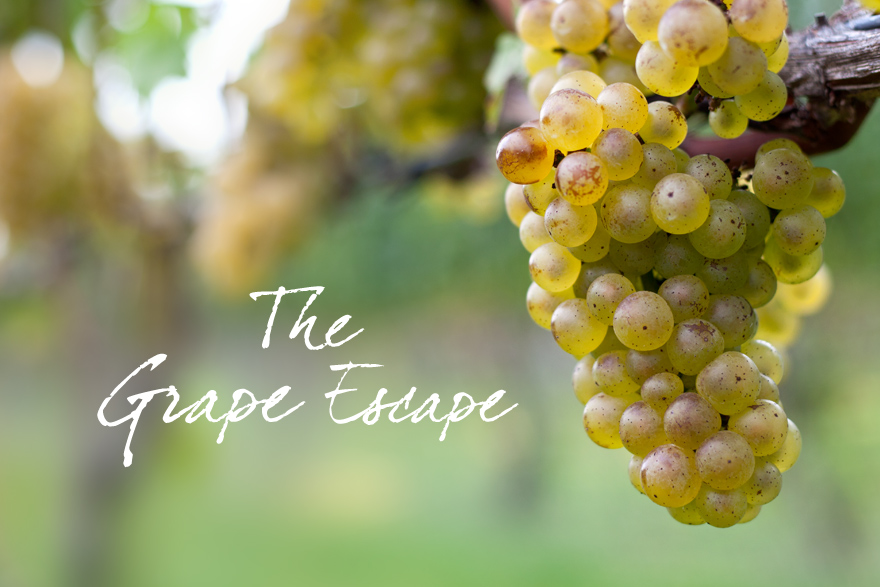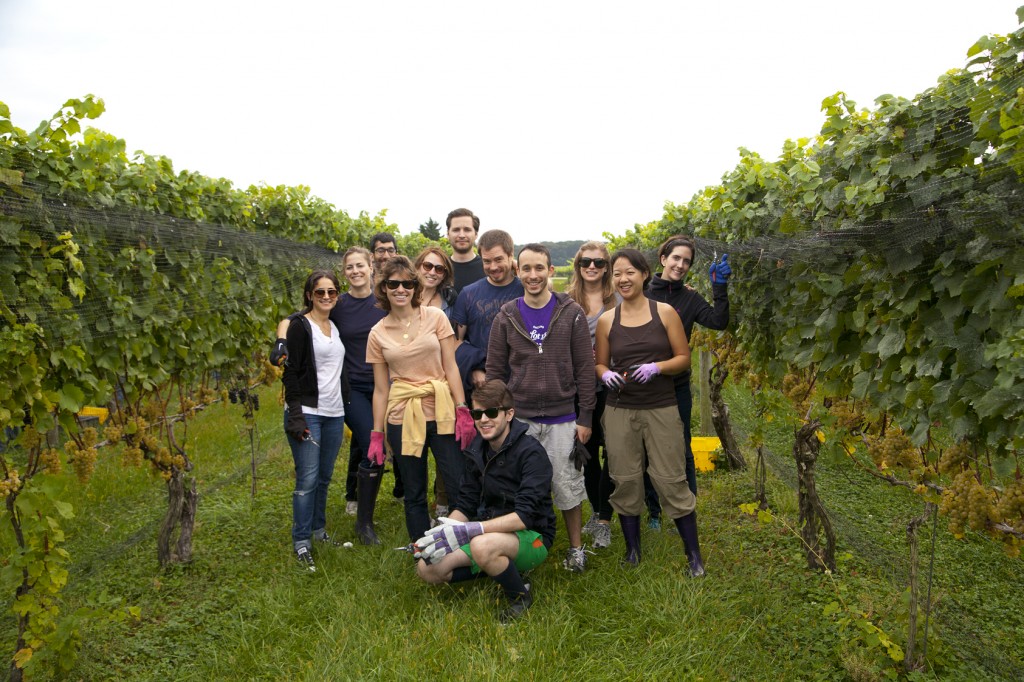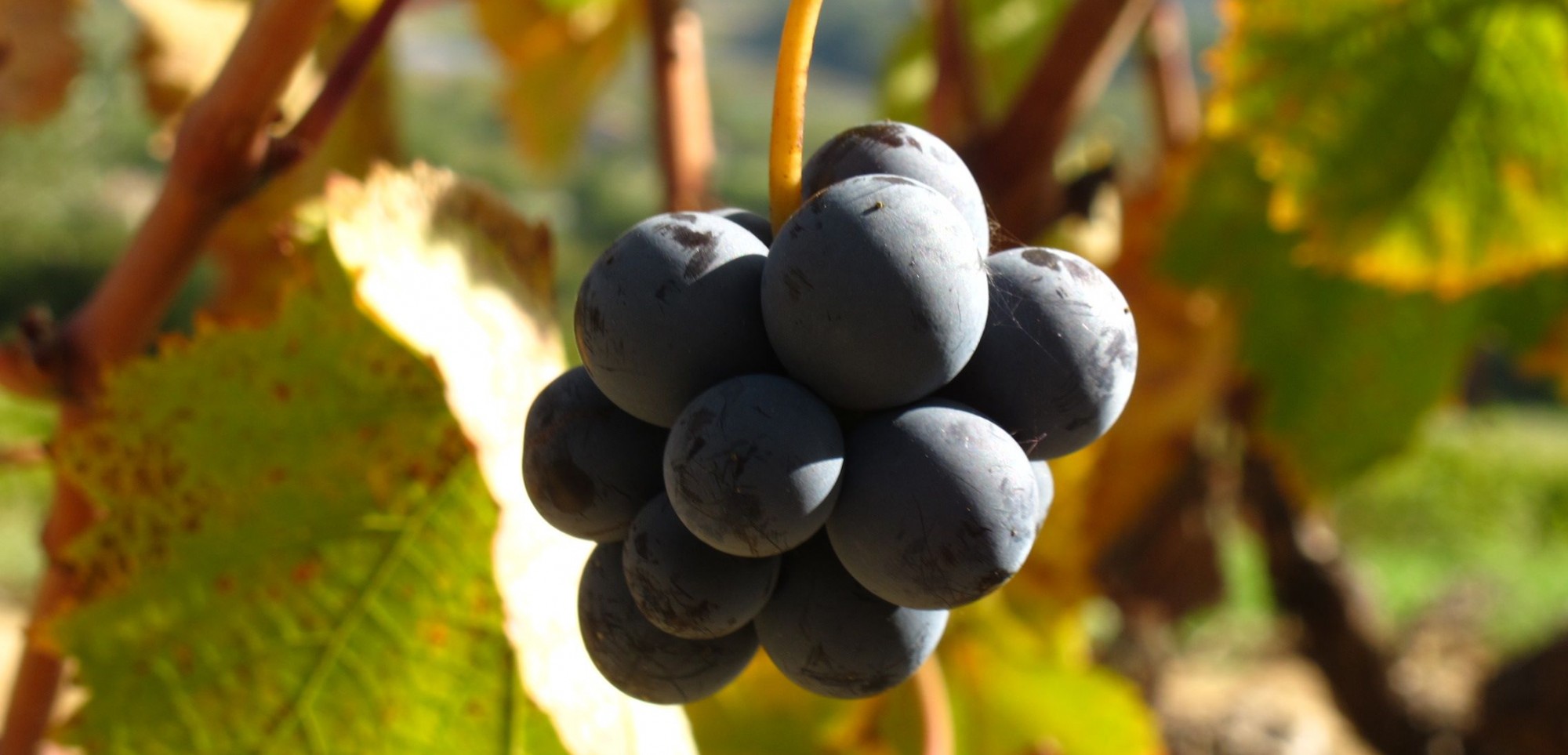The Grape Escape

Want your wine to taste infinitely better? Work a harvest. Yesterday, a crew from Lot18 took a break from coding, writing, designing, procuring and cracking the whip of compliance (just as painful as it sounds) and went to Channing Daughters Winery in Bridgehampton, Long Island. We were graciously hosted by winemaker Christopher Tracy and CEO Larry Perrine and allowed to pick Chardonnay grapes for a morning under their auspices. Afterward we all had a greater appreciation of the tremendous, meticulous work that goes into making a great wine.
Having never harvested grapes, I was a bit nervous. The words of our father hen, editorial director Eric Arnold, were ringing in my ears: “It’s important to pay attention, as picking is perhaps the most critical part of the winemaking process. How would you feel if you spent all year on a project, only for a group of strangers to show up at go time and make a mess of it?” Gulp.
Indeed it was go time as yesterday was the day Christopher and Larry decided that all white-wine grapes had to be finished picking. The 3.2-acre Brick Kiln Vineyard needed to be picked in its entirety, and would yield about 6.5 tons of grapes. With an eye on the overcast sky, we got our brand-new clippers and hopped to our harvest tutorial in a row lined with rectangular yellow bins. Christopher taught us how to clip the clusters and remove shriveled or rotten grapes, and then he left us to snip away. The grapes we harvested were destined for use in three Channing Daughters wines:
- Scuttlehole Chardonnay (stainless-steel fermented, no malolactic fermentation)
- Brick Kiln Chardonnay (fermented in old puncheons, full malolactic fermentation) and
- L’Enfant Sauvage (wild/ambient-yeast ferment, 100 percent new oak, full malolactic fermentation).

Our merry band of pickers: We are taking additional assignments, so feel free to contact us!
Besides us, Channing Daughters’ usual crew, some of who have been with the winery for multiple harvests, was already in action. They picked four rows in the time it took us to pick one. Maybe it took us longer, though, because we paused to nibble on a grape or two in the process, an activity sanctioned and encouraged by Christopher.
“As you tasted, saw and smelled for yourself, the 2012 vintage is absolutely great!” Christopher later emailed me. “We have picked about 130 tons already … all our whites are in, a couple reds and some grapes for rosé, too! We have about 50 tons of red fruit left out for both pink and red wines.”
With how tightly wound some of the clusters were around multiple branches, I became perplexed as to how machine harvesting is possible. “Tractors come down every row and shake the fruit off the vines,” Janine Lettieri, our imported wine director, explained. “The fruit gets bruised easily and oxidizes quickly, meaning more sulfites need to be added to stabilize the wine.”
While I wouldn’t have a clue as to the financials of hiring a crew to handpick vineyards much larger than Channing Daughters’, mechanized harvesting seems to take the very soul out of viticulture. Why go through the trouble of growing grapes at all if you’re going to manhandle (or machinehandle, rather) the fruit?
Larry described grape growing as cultivating hybrid tea roses every year; this parallel became obvious after we finished a row. The sense of accomplishment we all felt during our first coffee break – whew, picking for 45 minutes is hard! – was palpable as we dreamed about bottling a second cuvée18, a Channing Daughters Chardonnay made with the grapes we picked. We didn’t quite hit a ton, but the amount we snipped off will yield about 50 cases of wine.
Father hen Eric had told us that picking would be backbreaking, but we all found it extremely invigorating, especially after Chris allowed us a generous peek behind the winemaking curtain. We tasted fizzy Ribolla Gialla grapes right from the vat and sipped freshly pressed juice, which we passed around in an ample glass goblet. It tasted like sweet nectar.
When we returned to Brick Kiln, the rhythmic snip of our clippers filled the air, along with the bees angling for the same fruit we were after. Earwigs and ants feasted on any burst grapes in the clusters. We flicked the bad grapes away and handled the creepy crawlies as best we could. They are part of the terroir, and we were told that they were fine to go in the bins, along with the occasional leaf stuck in a tight bunch.
“When I make butternut squash soup, I don’t just use squash and apples. You need the bouquet garni,” Christopher said by way of explanation that grape picking, while meticulous, doesn’t need to be maddening. Everything on the vine adds to the wine’s character. He should know as he was a former chef.
“When we [Christopher and his wife, Allison Dublin, Channing Daughters’ general manager] first moved to New York, we were in the performing arts. Then we decided that we needed to be able to afford food, so I wrote reviews and became a chef. Then we decided that we needed to be able to afford food and drink, so I became a winemaker.”
That rationale makes complete sense if you spend even a second with Christopher. This man is bursting with creativity, as evidenced by his innovative blends: Is anyone else bottling a blend of Merlot and Blaufrankisch? It’s also easy to tell that Christopher, a native Californian whose parents grew grapes in St. Helena, feels right at home making wine 3,000 miles away in New York.
“Our moderate maritime climate allows and engenders this variety of styles within all the hues: white, pink, orange and red, in dry and sweet, still and sparkling. Diversity is one of our great strengths!” Christopher enthused. “Because of our climate, our wines have natural potential alcohol of 11.5 to 13 percent and bright, juicy, natural acidity. Many styles can be made without much, if any manipulation at all in the winery. This becomes much harder in warm/hot and dry districts.”

Winemaker Christopher Tracy and his happy pup, Remy.
Together with Allison, Larry and Walter Channing, the brand has grown from 4,000 cases and making five wines in 2002 to more than 20 varieties and 12,000-13,000 cases today. The synergy between Larry and Chris was palpable as they talked us through Channing Daughters’ history as we enjoyed their wine with our lunch.
“All of us don’t even have to talk to each other to get things done, we don’t have time to do that. We just give each other a look,” Larry said. As if on cue, Chris, who hadn’t been present when Larry said that, came out of the tasting room with his Labradoodle, Remy, and said the exact same thing.
I exchanged a look with Cat Lo, our art director, and knew we had to do a double-header of a blog post today. Please check out her amazing photography featured on Le voyage du vin to see a visual representation of the day outlined above. Be sure to have a good glass of wine from Channing Daughters in hand.
